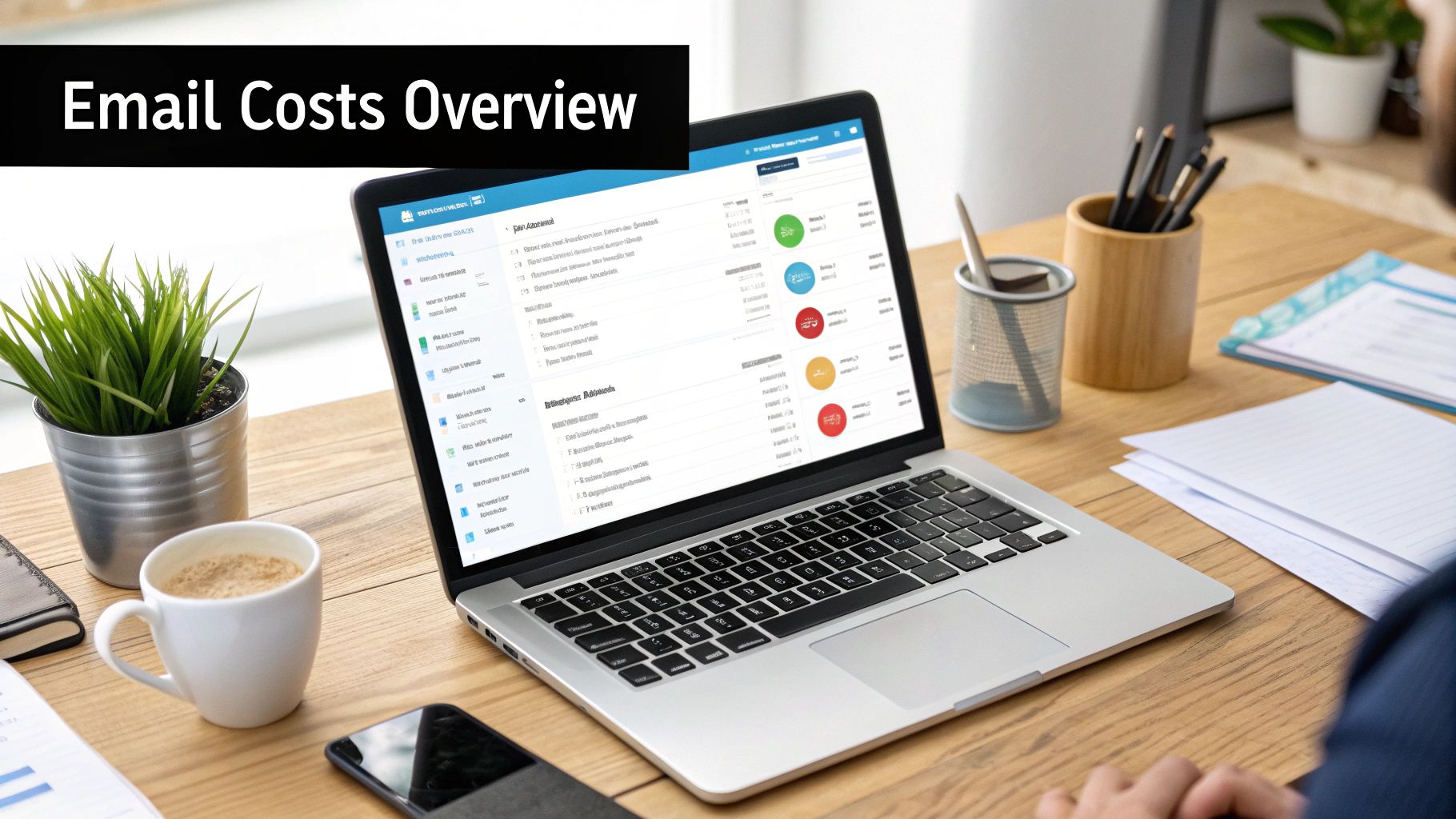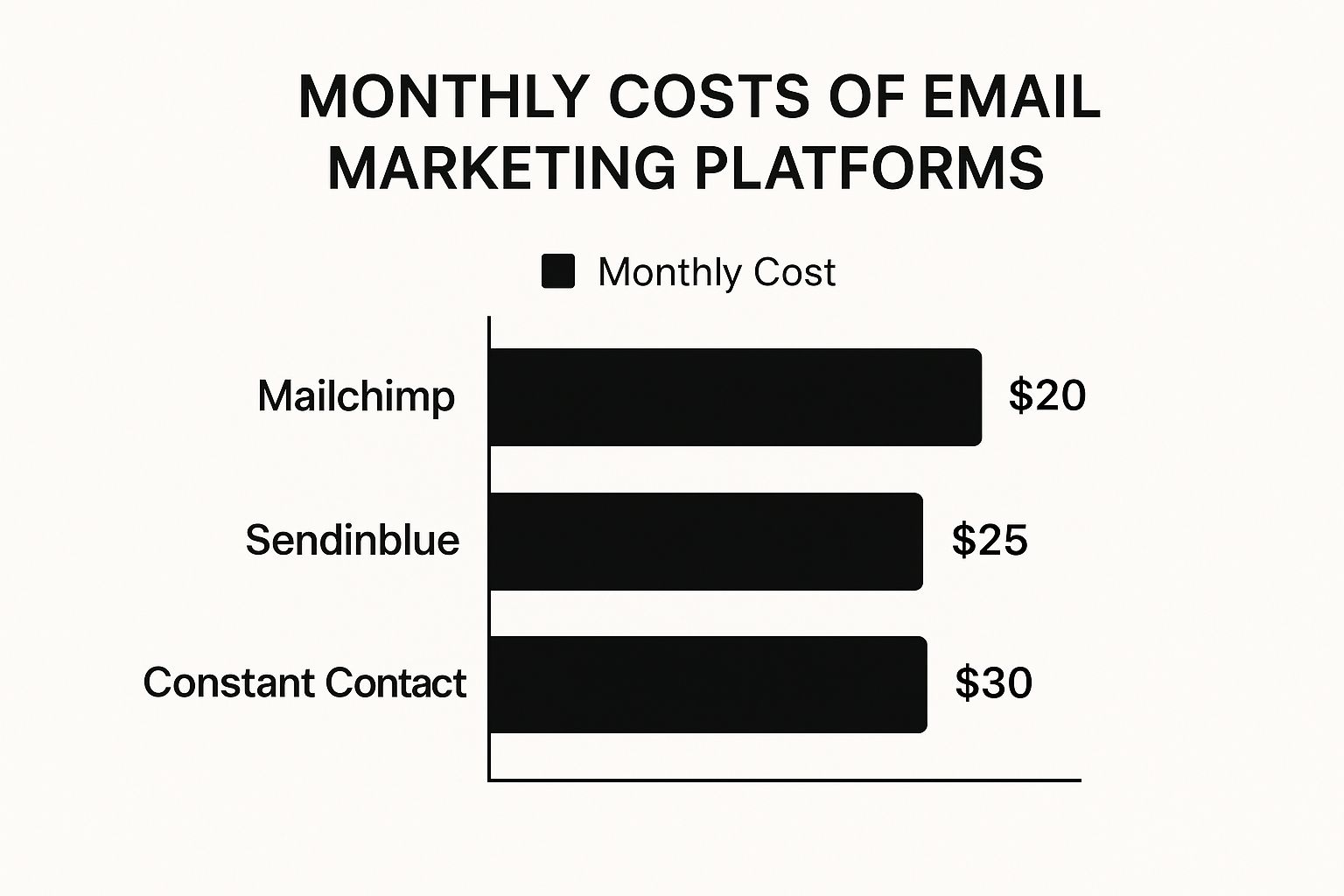Trying to pin down a single price for email marketing is a bit like asking, "How much does a car cost?" The answer can be anything from a few thousand dollars for a reliable used sedan to hundreds of thousands for a luxury sports car. It all depends on what you need it to do.
Email marketing is the same. Your costs can run from absolutely free for a brand-new blogger to well over $10,000 per month for a huge e-commerce brand. A typical small business with a couple thousand subscribers? You're probably looking at somewhere between $50 and $250 a month for a solid software platform.
Your final investment really boils down to your subscriber count, the features you can't live without, and whether you're running the show yourself or bringing in the pros.
What Goes Into Your Email Marketing Bill?

Think of your email marketing strategy as a custom-built toolkit. You're not buying a one-size-fits-all product. Instead, you're piecing together the right tools for your specific goals. You can start with a basic, budget-friendly setup that handles the essentials, or you can go for a high-performance system with all the bells and whistles.
What you end up paying is a direct reflection of those choices. To make a smart decision, you need to get familiar with the three main levers that control your costs: your audience size, the sophistication of your campaigns, and the service model you choose.
The 3 Core Cost Factors
The biggest single factor that will drive your email marketing costs is the size of your subscriber list. Nearly every email marketing platform uses tiered pricing. As your list grows, so does your monthly bill. It’s simple math: a list of 1,000 subscribers will always be cheaper to manage than one with 50,000.
Beyond just the numbers, the specific features you need are a huge part of the equation.
- Basic Plans: These get you in the door with standard newsletters, simple sign-up forms, and basic email builders. Perfect for getting started.
- Advanced Plans: This is where you unlock the real power. Think complex automation sequences, sophisticated A/B testing, AI-driven content suggestions, and deep analytics.
These advanced features are the turbo engine for your marketing efforts—they cost more upfront but can generate far more impressive results and a much higher ROI.
A critical piece of the puzzle is understanding the true value of your efforts. Learning how to calculate customer acquisition cost helps you see if your email marketing spend is actually paying off by bringing in profitable customers.
Finally, your choice of service model will dramatically change your budget. A do-it-yourself approach using software is the most direct and affordable path, but it costs you time and requires you to learn the ropes. Handing the keys to a full-service agency gives you instant expertise and execution, but for a much higher monthly retainer. We'll explore how to figure out which path is right for you.
How Email Marketing Pricing Models Work

Before you can figure out how much to budget for email marketing, you need to get a handle on how providers actually charge for their services. Think of it like picking a cell phone plan—the right choice for you boils down to your specific needs and how you plan to use it. Your total email marketing costs are a direct result of the pricing model you land on, and each one is designed for a different kind of business.
Let’s break down the three most common pricing models you'll run into. Getting your head around these is the first real step to building a budget that’s both predictable and ready to grow with you.
Pay-by-Subscriber Model
The most common setup you’ll see is the Pay-by-Subscriber model. It’s pretty simple and predictable, kind of like a Netflix subscription. The more subscribers you have on your list, the higher your monthly bill. Simple as that.
This model is a fantastic fit for businesses that send out emails on a regular schedule, like a weekly newsletter or frequent promotional offers. You generally get to send as many emails as you want (within reason, of course) without your bill changing. That consistency makes budgeting a breeze.
But there’s a catch. You’re paying for every single person on your list, including the ones who haven't opened an email in a year. This is exactly why keeping your list clean is so important. Paying for thousands of inactive contacts can seriously inflate your email marketing costs for zero return.
Pay-as-You-Go Model
Next up is the Pay-as-You-Go model, which operates more like your electricity bill. Instead of a flat monthly fee, you buy a batch of email credits and only use them up when you actually send a campaign. This gives incredible flexibility to businesses that don't email on a set schedule.
Take a seasonal business, for example—maybe a retailer who does most of their business around the holidays. A Pay-as-You-Go plan is perfect because they aren't stuck paying a monthly fee during their slow months. It’s also a great starting point for new businesses still trying to find their rhythm with email.
Key Insight: This model separates your cost from your list size. You could have a huge list of 100,000 subscribers, but if you only email them once a quarter, you'll spend far less than you would on a subscriber-based plan.
The trade-off is that the cost-per-email is usually a bit higher than with a monthly plan. If you suddenly need to send more frequently, your costs can jump unexpectedly. It's a great model, but before diving in, it's wise to have a plan for consistently generating leads for email marketing to make sure you have a quality audience to connect with when you do decide to send.
Usage-Based Tiered Models
Finally, we have Usage-Based Tiered models, which are getting more and more popular. The best analogy here is an arcade. You buy a bunch of tokens (credits) that you can spend on different things—not just sending emails, but also unlocking premium features like advanced automation, AI copywriting tools, or priority support.
This setup provides a nice middle ground between the other two models. You might pay a base fee that covers a certain number of contacts and emails, with the freedom to upgrade to a higher tier or buy add-ons as your needs get more sophisticated.
This is a huge plus for growing businesses that want to scale their efforts without making a massive leap to a pricey enterprise plan. For instance, you could start with a basic tier and then bolt on an A/B testing feature once you're ready to start optimizing your campaigns.
That flexibility is the main draw, but it can also make your budget a bit harder to predict. You have to keep a close eye on what you're using to avoid surprise fees or hitting a feature limit right when you need it most. Always read the fine print on each tier to make sure you aren't paying for powerful tools you'll never touch.
The Hidden Costs of Email Marketing
https://www.youtube.com/embed/O-wq-C-52NY
When you're shopping for an email marketing platform, it’s easy to focus on that one big number: the monthly subscription fee. But if you stop there, you’re missing a huge piece of the puzzle. That fee is just the price of entry.
Thinking the platform is your only expense is like buying a high-performance car and forgetting you'll need to pay for premium fuel, insurance, and regular maintenance. To get a real sense of what your email program will cost, you have to look at all the moving parts that actually make it successful. These "hidden" costs are where budgets often get busted.
Let's break them down so you can plan properly and avoid any nasty surprises down the road. This way, you can invest your money where it counts instead of just trying to find the cheapest option.
The Investment in Content Creation
Let's be honest: your emails are nothing without great content. But crafting compelling copy and stunning visuals doesn't happen by magic. It costs time, money, or, more realistically, a bit of both. This is easily one of the biggest "hidden" expenses in any email marketing effort.
You need professional copywriting to nail those subject lines that beg to be opened and messages that guide readers to act. Likewise, high-quality design—whether it’s custom graphics, branded templates, or even well-chosen stock photos—is what makes your emails stand out in a crowded inbox. You can either hire this out to freelancers or an agency or dedicate serious in-house hours to get it right.
Here's a quick rundown of the content pieces you’ll need to budget for:
- Copywriting: Writing the email itself, plus killer headlines and crystal-clear calls-to-action.
- Graphic Design: Creating custom banners, images, and maybe even a few GIFs that feel like your brand.
- Email Templates: Building reusable, mobile-friendly templates to keep your campaigns looking consistent and professional.
- Photography/Videography: Sourcing or shooting original visuals that make your content pop.
The Cost of Human Resources
Beyond the content itself, you need people to pull all the levers. The human element—the person or team actually running your email program—is a major cost you can't ignore. You generally have two ways to go here, each with its own price tag.
You could hire an in-house email marketing specialist, which means factoring in salary, benefits, and ongoing training. The other path is to outsource the work to a marketing agency or a freelance pro. Freelancers might offer lower hourly rates, but a full-service agency can bring a whole team of strategists, writers, and designers to the table for a single monthly retainer.
To really tackle the hidden costs of manual work and get the most out of your team, it's worth learning how to automate repetitive tasks in your workflow. This frees up your people to focus on strategy and creativity instead of just clicking buttons.
Protecting Your Sender Reputation
Here's a cost that’s easy to overlook until it’s too late: keeping your email list clean. Firing off emails to invalid or dormant addresses is a fast track to tanking your deliverability and getting your domain blacklisted. That’s where list verification services come in.
These tools scrub your list, weeding out typos, fake addresses, and dangerous spam traps. This ensures your emails actually land in front of real people. It's a small extra fee, but it's a crucial investment in protecting your sender reputation and making sure your entire effort isn't wasted.
The sheer volume of email makes this essential. In 2022, an estimated 333 billion emails were sent every single day to over 4.26 billion users worldwide. This massive audience makes email incredibly powerful, but only if you can reliably reach the inbox.
Choosing Your Email Marketing Approach
Deciding how to run your email marketing is a major crossroads. The path you choose will directly impact your budget, your daily workflow, and ultimately, your results. It's not about finding one "best" way—it's about finding the right way for your specific business, considering your team's skills, budget, and how much time you can realistically commit.
You essentially have three main options: using a ready-made software platform (SaaS), hiring a dedicated marketing agency, or going the DIY route with a self-hosted system. Each comes with its own unique blend of costs, control, and convenience. Let’s break them down to see which one fits you best.
SaaS Platforms: The All-Rounder
For most businesses, from brand-new startups to established companies, using a SaaS (Software-as-a-Service) platform is the go-to choice, and for good reason. Think of well-known names like Mailchimp, ConvertKit, or beehiiv. These tools hit the sweet spot, offering powerful features at a price that doesn’t break the bank.
The biggest draw here is getting professional-grade tools without the technical headaches. You pay a predictable monthly fee, usually tied to how many subscribers you have, and in return, you get everything you need—drag-and-drop builders, automation sequences, detailed analytics—all ready to go. You can focus on crafting a great message instead of worrying about server uptime.
This image gives you a snapshot of what entry-level plans from popular platforms might cost.

As you can see, you can get started with a seriously capable platform for less than $30 a month.
Marketing Agencies: The Hands-Off Experts
Hiring an email marketing agency is a completely different ballgame. You’re not just buying software; you're outsourcing your entire email strategy and execution to a team of pros. The email marketing costs here reflect that, typically falling into a $500 to over $7,000 per month retainer.
So, what does that investment get you? Expertise, and just as importantly, your time back. An agency handles it all: strategy, copywriting, design, sending the campaigns, and poring over the data to see what worked. It's the perfect fit for businesses that know they need to be doing email marketing well but don’t have the in-house skill or bandwidth to pull it off.
Key Insight: You’re paying for outcomes, not just a service. A great agency lives and breathes this stuff. They bring a deep understanding of deliverability, audience segmentation, and conversion tricks that are tough to replicate on your own.
Of course, this approach requires a bigger budget and a lot of trust. You're handing over a critical piece of your customer communication. It's best for established companies ready to invest seriously in their email ROI. If you're a smaller operation, you can still get fantastic results on a tighter budget by learning the ropes yourself. Our guide on email marketing tips for small biz has plenty of actionable advice to get you started.
Self-Hosted Solutions: The High-Control, High-Effort Path
The final route, building a self-hosted email system, is by far the most technical. This means taking open-source software and running it on your own servers. At first glance, it looks incredibly cheap—the software itself is often free, and you just pay for server hosting.
But don’t be fooled. Those low upfront costs hide a mountain of responsibility and "hidden" work. When you self-host, you essentially become your own email service provider. That means you are 100% on the hook for:
- Server Maintenance: Keeping the lights on and ensuring your servers are secure and configured perfectly.
- Software Updates: Constantly managing patches and updates to plug security holes.
- IP Reputation Management: This is a big one. You have to actively protect your sending IP address from getting blacklisted by providers like Gmail and Outlook.
- Deliverability: The whole complex art of making sure your emails actually land in the inbox, something SaaS platforms handle for you.
This path demands deep technical know-how. You need someone who truly understands server administration and email protocols. While it offers total control and can be cost-effective at a massive scale, the risk, time, and specialized knowledge involved make it impractical for almost everyone except large, tech-savvy organizations.
To help you weigh these options side-by-side, let's put them into a clear comparison.
Comparing Email Marketing Management Approaches
This table breaks down the key differences in cost, benefits, and what's required from you for each approach.
| Factor | SaaS Platform | Marketing Agency | Self-Hosted Solution |
|---|---|---|---|
| Typical Cost | $15 – $500+/mo | $500 – $7,000+/mo | $10 – $1,000+/mo (hosting) + Staff Time |
| Best For | Startups, SMBs, most businesses | Mid-to-large businesses lacking time/expertise | Large-scale senders with technical teams |
| Technical Skill | Low – plug and play | None required | High – expert level required |
| Time Investment | Medium – content creation and management | Low – primarily review and approval | High – ongoing maintenance and troubleshooting |
| Key Benefit | Affordability, ease of use, and scalability | Expert strategy, execution, and time savings | Maximum control and customization |
| Main Drawback | Can get pricey at large scale | Highest direct cost, less hands-on control | High risk, complex, and resource-intensive |
Ultimately, the best choice aligns with your current reality. A SaaS platform offers a fantastic, balanced starting point for most, an agency provides a powerful accelerator for those with the budget, and a self-hosted solution is a specialized tool for a very specific need.
How To Maximize Your Email Marketing ROI

It’s easy to get caught in the trap of hunting for the cheapest email platform. But while keeping an eye on email marketing costs is smart, the real win isn't about spending less—it's about earning more. We need to shift the conversation from expense to profit, and that all boils down to one crucial metric: Return on Investment (ROI).
ROI cuts through the noise and tells you exactly how much money you’re making for every dollar you put in. It's the ultimate report card for your marketing because it ties your efforts directly to the bottom line. A dirt-cheap plan that brings in zero sales is a total waste, whereas a pricier, feature-packed service that drives serious revenue is a brilliant investment.
Email marketing continues to be a powerhouse, consistently delivering an incredible ROI. On average, businesses see a return of $36 to $42 for every $1 spent. That kind of return often leaves other digital channels, like paid ads, in the dust.
Calculating Your Email Marketing ROI
Figuring out your ROI isn’t some complicated financial wizardry. You just need to know two key numbers: how much you spent on your email efforts and how much revenue those emails brought in.
The formula is straightforward:
(Total Revenue from Email – Total Email Campaign Cost) / Total Email Campaign Cost * 100 = ROI %
Let's walk through a quick example. Say you spent $500 last month. That includes your email software subscription and any costs for content or design. In that same month, your campaigns generated $7,500 in direct sales.
Here’s how the math plays out:
($7,500 – $500) / $500 * 100 = 1,400% ROI
That number tells a powerful story: for every single dollar you invested, you got $14 back. This is the kind of data that justifies your budget and helps you make the case for investing in better tools or strategies to drive that number even higher.
Smart Strategies To Boost Your Returns
Knowing your ROI is just the starting point. The real work is in making that number grow. And spoiler alert: the answer isn't just "send more emails." It's about sending smarter emails that truly connect with your audience.
Here are three powerful ways to get more bang for your buck:
Hyper-Segment Your Audience: Stop sending the same generic blast to everyone. Group your subscribers by their behavior—what they’ve bought, what they’ve browsed, or what they’ve shown interest in. A customer who just bought hiking boots needs a very different follow-up than someone who only looked at running shoes. Better segmentation always leads to better open rates, more clicks, and more sales.
Personalize at Scale: This goes way beyond using someone’s first name. Think about using dynamic content to show product recommendations based on their browsing history or mentioning their local store in a promotion. This is how you make subscribers feel seen and understood, not just marketed to.
Embrace Automation: Automated email sequences—often called "drips" or "flows"—are your 24/7 sales team. These are pre-built series of emails that get triggered by specific actions, like when someone signs up, makes a purchase, or abandons their cart.
Automated emails, such as welcome series or abandoned cart reminders, are insanely efficient. They might only be a small fraction of your total email volume, but they often punch way above their weight, driving a huge portion of email-generated revenue with minimal ongoing effort.
To really sink your teeth into the tactics that make a difference, explore these proven strategies to boost your email marketing ROI. Ultimately, a strategic investment in your email program, focused squarely on value instead of pure cost-cutting, is what turns a simple mailing list into a reliable revenue machine.
Frequently Asked Questions
It’s completely normal to have a ton of questions when you're trying to figure out email marketing costs. Let's walk through some of the most common ones I hear from business owners, so you can build your budget and strategy with confidence.
How Much Should a Small Business Budget for Email Marketing?
If you're a small business, a realistic starting point for email marketing costs is usually somewhere between $25 to $150 a month.
That budget typically gets you access to a solid SaaS platform packed with the tools you actually need to see growth—things like automation, segmentation, and good, clear analytics. It’s the sweet spot, giving you a professional-grade toolkit without the much larger investment of hiring an agency. This allows you to manage a list of a few thousand subscribers and send out campaigns that genuinely move the needle.
Are Free Email Marketing Services Good Enough to Start With?
Absolutely. For anyone just dipping their toes in the water, a free plan is a fantastic way to start. It gives you a no-risk environment to build your first subscriber list and get a feel for how to create and send emails.
Just know that you'll likely outgrow it, and probably sooner than you think. Free plans almost always have strings attached, like a cap on your subscriber count, limited features, or their logo stamped on the bottom of your emails. They're a great launchpad, but as your business scales, you'll need the advanced tools that only a paid plan can offer.
The moment you realize you need more sophisticated ways to nurture your audience is usually the sign it's time to upgrade. For more general business questions, our main FAQs page has some great insights.
What Are the Most Common Hidden Fees to Watch Out For?
The price you see on the website is rarely the full picture. One of the sneakiest costs to look out for is overage charges. Most plans have firm caps on subscribers or email sends, and if you go over, you can get hit with some unexpectedly high fees.
Here are a few other things to keep on your radar:
- List Cleaning: Services that verify your email list to boost deliverability almost always cost extra.
- "Advanced" Features: Be careful—some platforms will lock essential tools like A/B testing or premium automation behind their most expensive plans or sell them as separate add-ons.
- Custom Templates: While you'll get plenty of free templates, if you want something truly unique and professionally designed for your brand, that's an additional cost.
Always take a few extra minutes to read the fine print. Understanding the full scope of potential email marketing costs before you sign up will save you a lot of headaches down the road.
Ready to build an online presence that turns visitors into loyal customers? Sugar Pixels offers everything from custom website design and SEO to strategic email marketing services that drive growth. Let our team of experts handle the technical details so you can focus on your business. Explore our solutions and start your project today.